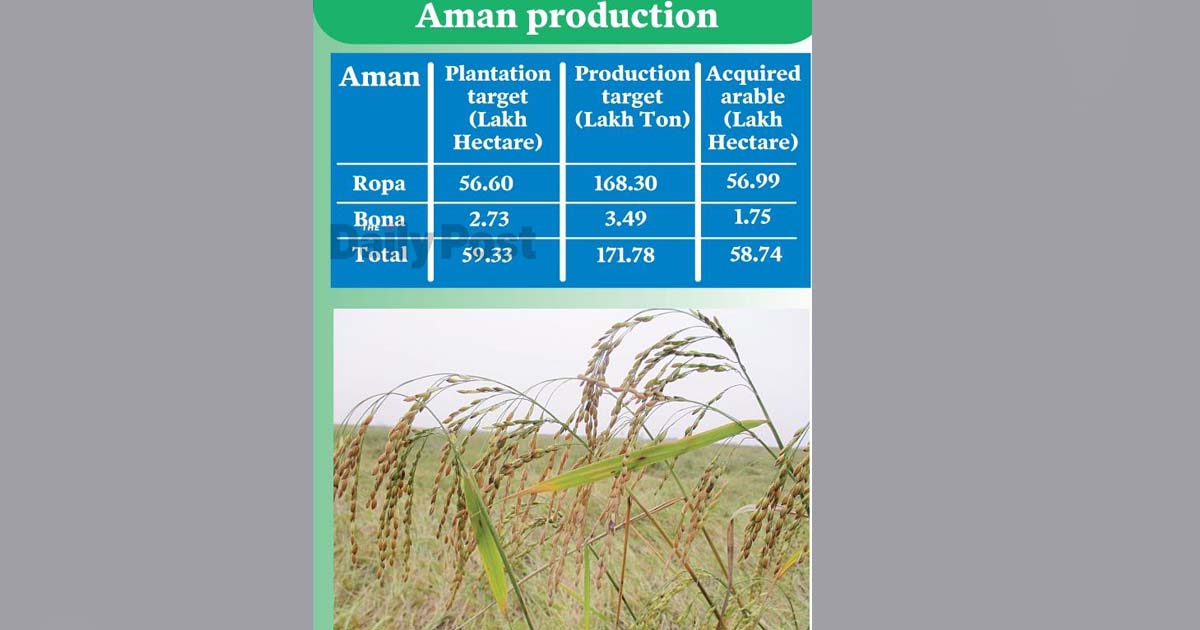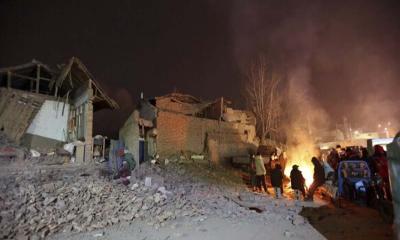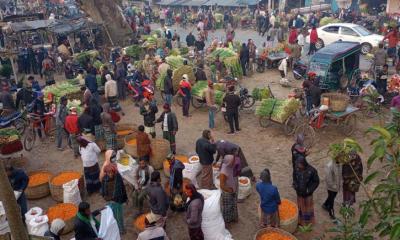The Department of Agricultural Extension (DAE) has set a target of producing about 1 crore 72 lakh tons of rice in the current Aman season. Meanwhile, 75 percent of the cultivated paddy has been harvested this season. A regular report of DA has claimed that Aman will cross the production target due to increased yield.
According to the forecast of the organization, the total production of rice in the current Amon season will be around 1 crore 75 lakh tons. 40 percent of the total rice production in the country is during Aman season. Although the crop is not as expected, according to the DA's calculations, this time rice production is going to miss the company's target. DAE had taken up the target of paddy cultivation in a total of 59 lakh 33 thousand hectares of land during the Aman season. Out of this, 58 lakh 74 thousand hectares of land have been cultivated. Around 40,000 hectares of paddy have been damaged by insects and cyclones Midhili and Migjaum. However, DAE officials believe that the level of damage is less than expected and the yield per hectare is good, so the production is going to be higher than the target.
According to the data of DA, a total of 43 lakh 79 thousand hectares of land has been harvested so far. The production of rice in the land that has been harvested is estimated to be 1 crore 28 lakh 74 thousand tons. The average yield is 2.94 tons per hectare. 4.2 lakh 89 thousand hectares have been cultivated out of the land that has been harvested. Rice production from here is estimated at 1 crore 27 lakh tonnes. And sown (Bona) Aman has been planted in 90 thousand hectares of land. Production from there is estimated at 1 lakh 20 thousand tons.
Taking the average yield of the land that has been harvested, a total of 1 crore 74 lakh 98 thousand tons of rice can be produced in the Amon season, DA said.
The preliminary statistics of rice production are prepared by DAE but the final statistics are prepared by the Bangladesh Bureau of Statistics (BBS). Every year there is a huge gap between these two figures. Again, the production data of international organizations shows that it is even less. The policymakers of the government have expressed their anger about this at different times and said that the lack of accurate production data has become an obstacle to taking appropriate policies.
However, this time overall, the yield of paddy in the Amon season has been relatively good, according to many of the stakeholders including farmers. Some districts of the Rajshahi division including Naogaon are at the center of rice supply management in the country. The farmers here also said that this year the yield of paddy has been good compared to other times. Farmer Rezaul Mandal of Chakpanderpur village of Chandash union of Naogaon's Mahadevpur upazila said, "I planted Swarna-5 variety of Aman paddy on one and a half bigha land. Tk12 thousand have been spent including paddy cutting and threshing. 30 maunds of paddy yielded. This paddy is being bought and sold at the price of Tk1 thousand 100 in the local market. At least Tk21 thousand will be gained by selling paddy this time. Overall, the yield of rice has been good.
When asked about the overall cultivation situation of the district, Deputy Director of Naogaon Agricultural Extension Department Abul Kalam Azad said, 'Aman paddy was cultivated here on 1 lakh 94 thousand 875 hectares of land. 95 percent of its rice has already been harvested and threshed by the farmers. A target of 3.29 tons of paddy production per hectare has been set, but due to favorable weather conditions, 3.35 tons per hectare is being produced. We are hopeful that at least 15 thousand tons more rice will be produced this year than last year.
The yield of paddy has also been relatively high in Jhenaidh district in the southwestern part of the country. Farmers said that the price of paddy was good this time even though it was not as expected due to rain.
Farmer Ravi Rahman of Sadar Upazila of Jhenaidah said, 'Aman paddy has been good this year. I cultivated Guti Swarna paddy in one bigha of land. About 28 maunds of paddy have been harvested. I sold 1 thousand 120 taka per maund of paddy. But earlier the market was good. Due to the rains, the prices fall. Still, I got a relatively good price.
The same picture was seen in Bogra in North Bengal. Here, Aman rice was cultivated on 1 lakh 83 thousand 510 hectares of land. Six lakh tons of rice have been produced from there.
Farmer Tanveer of Bogra Sadar Upazila said, "The price of fertilizers and pesticides was high this time. I got 18 maunds of paddy per bigha. I have sold Tk1 thousand 150 to 1 thousand 200 per maund of paddy. If it was Tk1 thousand 500 per maund then it would be good. Faridur Rahman, deputy assistant agricultural officer of the district agricultural extension department, said, "We have had a good yield this year. Farmers got about 18 maunds of rice per bigha. Again, the price of rice was high in the market.
Cyclone Midhili hit last month. It affected about two lakh hectares of Aman paddy land. Out of this, about 13 thousand hectares of rice was damaged. On the heels of Midhili's damage, Cyclone Migjaum, which formed in the Bay of Bengal this month, hit the coast of the Indian state of Andhra Pradesh. As a result of the heavy rains in various districts of the country, some paddy fields were affected.
Farmers have reported damage to Aman rice due to insect attacks in some parts of the country. In a few upazilas of Netrakona, paddy has been slightly damaged by the attack of the cutworm.
Abu Chan Miah, a farmer of Tenga village in Medni union of Sadar upazila, said, "This year the yield of a man has been good, paddy is also on the way to harvesting. However the desired yield could not be raised due to the attack of the leaf beetle. The leaf beetle has cut the grain of the growing crop in the field. The use of drugs to prevent the attack did not help.
Experts and stakeholders see the fact that rice production is good as a positive for market management. Director General of Bangladesh Rice Research Institute Dr. Shahjahan Kabir Banik said the production of rice has been very good in the past seasons. This year there has been good production in the Aman season as well. There is no shortage of rice in the country. No need to import rice unless there is a major disaster. The government imports rice when the collection is low. The government's stockpile capacity has been steadily increasing. It should be increased. Farmers are getting good prices by selling paddy. It must be held. Then the government will not need to import rice. Just need to ensure uninterrupted supply. Be careful not to disturb it under any circumstances. That's why everyone should show maximum patriotism. Only then will there be a comfortable situation in the country's food situation, especially in rice.
Despite this, the lack of proper information about the production is causing great concern in rice market management. The Department of Agriculture Extension gave preliminary information about the production of 1 crore 70 lakh tons of rice in 59 lakh 2 thousand hectares of land in the last financial year. After that, the final data published by BBS shows that about 1 crore 54 lakh tons of rice has been produced in 57 lakh 5 thousand hectares of land. That is, the discrepancy between DAE and BBS data is more than 16 lakh tons. Again, a report by the United States Food and Agriculture Organization (USDA) gave the figures for production of 1 crore 46 lakh tons in the Aman season last year. Abdul Latif Mondal, the former secretary of the Ministry of Food, said, "Every year, the organizations give different information about the production statistics. Since there is an overall shortage this year, a survey can be done by BBS specifically on rice production and stocks. Then the picture will be understood. Aman will rise now. So rice doesn't seem to be needed for now. However, if there is a weakness in the figures, a crisis could emerge by March. Then, if there is a crisis, the price may increase again or the market may become unstable.
In the fiscal year 2022-23, about 10 lakh 56 thousand tons of rice were imported into the country. However, no rice has been imported so far in the current financial year. In October last, the Food Planning and Procurement Unit (FPMU) meeting of the Food Ministry decided not to import rice until the Amon season rice was in the market. Although rice is not imported this year, the rice market is very stable. Although the price of coarse and medium size rice increased slightly last month, the price of Aman rice started to come down in the market.
According to the information of the Ministry of Food, now the government has about 12 lakh tons of rice in stock.
Along with this, the collection of Amon is going on. It has been decided to buy two lakh tons of paddy, four lakh tons of boiled rice, and one lakh tons of Atap rice in the current Aman season. Then on December 12, a decision was taken to procure another two lakh tons of rice from the Ministry of Food. Among them, one and a half lakh tons of boiled and 50 thousand tons of Atap rice. Till now about 1 lakh 70 thousand tons of rice has been collected.
When asked about the overall issue, Joint Secretary of the Ministry of Agriculture ATM Saiful Islam said, "The amount of rice we produce is more than the demand. But every year some rice has to be imported to balance the market. Because if not, businessmen will take advantage. Aman production has been good this year. Even if there were cyclones or other problems, it did not affect much. Our target will be met.
ARS














